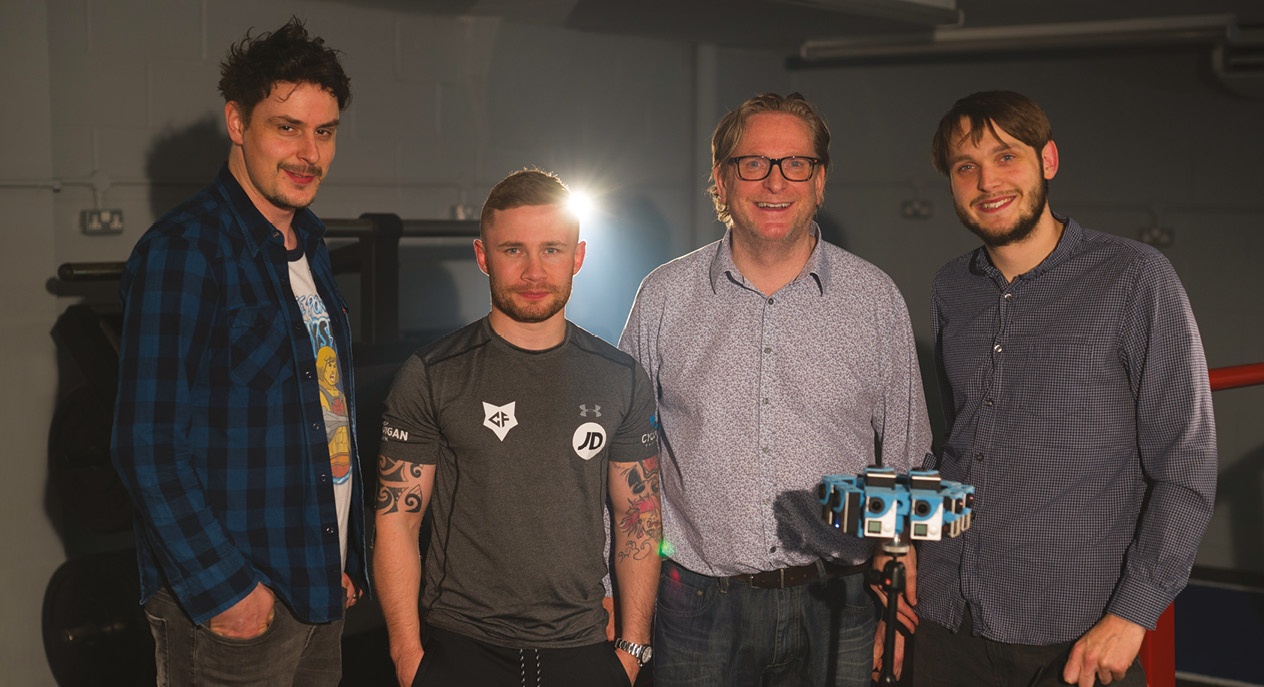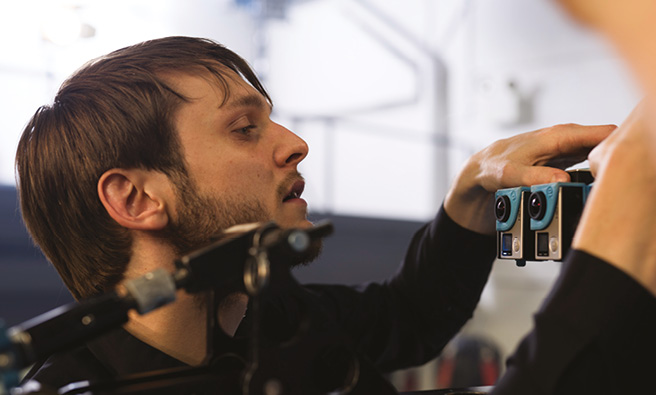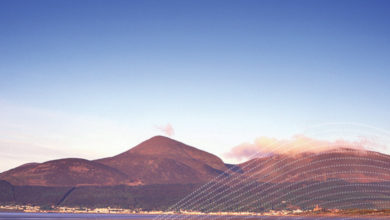Virtues of virtual


While the technology owes itself to an extensive legacy, virtual reality (VR) and augmented reality (AR) has proliferated dramatically in the last decade. Now huge multinationals such as Facebook, Google, Apple, Amazon, Microsoft, Sony and Samsung all have dedicated VR and AR subsidiaries. Ciarán Galway discusses the technology with Belfast-based VR expert Jack Morrow.
There is a distinct difference between VR and AR. Morrow explains: “VR is about immersing individuals in an alternative environment. It’s about taking you from a space in front of your computer and transporting you to anywhere else of your choosing.
“Meanwhile, AR is about taking objects and placing them into your existing reality. For instance, in its most basic form it’s about filtering objects through a camera, as exemplified by Snapchat lenses. An AR platform can be integrated into smartphone cameras and enables the user to alter the facial characteristics of individuals. Products pioneered by companies such as Magic Leap will place objects directly into our eyesight and the ultimate aim is to render these indistinguishable from things we see in the real world.”
Longevity
VR is currently breaking out of its popular portrayal as a gimmick and moving in several directions. Morrow illustrates: “Since Oculus was acquired by Facebook in a $2 billion deal, the whole industry has awoken. HTC and Valve have put together the HTC VIVE which is even more advanced than the Oculus Rift. PlayStation VR also emerged in the same timeframe. There are also simpler permutations of VR which utilise the latest smartphones to create a very immersive virtual reality experience.
“As such, what we’re starting to see are things like cinematic VR or 360° video. It’s being used in training, it’s being used in healthcare, it’s being used in surgery and it’s being used in education. For instance, children can ‘visit’ the Egyptian pyramids, they can ‘go under the sea’ to study the scale of the blue whale and they can interact with and be educated by experts and noteworthy historical figures.
“The main difference between now and the 1990s is cost. Whilst VR was explored mainly through military research in the 1990s, now anyone can have the basic hardware sitting in their pocket. That’s a huge transformation and if you want to access other environments, it is now increasingly possible and affordable.”
Evolution
Only a few years ago, while the concept was clear and it worked, VR wasn’t a comfortable experience and it was relatively low-resolution. Since then, as people have been introduced to mass consumer releases of products, such as the Oculus Rift CVI and Google Cardboard (an affordable piece of carboard with a pair of lenses that enables a consumer to turn any phone into a VR headset). “Last year, we had all the official consumer releases launching and the quality of those, while it’s difficult to objectively measure these things, has improved dramatically. For instance, resolution has increased massively, sharpness of the lenses has improved and the way things are rendered has been enhanced,” Morrow illustrates.
Mainstream
VR has now penetrated the mainstream and millions of users worldwide own Samsung’s Gear VR, PlayStation VR, Oculus and Vive headsets. Morrow elaborates: “For instance, Samsung are now beginning to give away more and more VR headsets for free with their latest phone contracts. Over the next year, it’s anticipated that Gear headset usage will jump from five million to 15 million.
“Google have launched Daydream. In the near future, all Android phones will be Daydream compatible. Every single tech company is investing in this technology and recognising that this is the way the world is going.”
Morrow suggests: “While still niche, certainly in global terms, there’s been a substantial jump in uptake. The key here is that a very clear business model can be established around VR. If you can get 200,000 people paying £40 for the experience, then suddenly developers who are considering entry into this market begin to think: ‘Oh, there is a market!’ Whereas, two years ago there may not have been and the lucrative nature of VR gaming hadn’t yet revealed itself.”
 Jack Morrow, VR Technical Director at Belfast-based cinematic VR company Retinize.
Jack Morrow, VR Technical Director at Belfast-based cinematic VR company Retinize.
Transformative
The VR expert concedes that it’s difficult to quantify exactly how transformative the technology is going to be. “This isn’t going to render obsolete all existing mediums overnight. People will still want to go to the cinema, people will still play computer games on their PC monitor and people will still socialise in the real world. As someone who works in the VR sphere I can do both and I enjoy doing so and when the headsets get more comfortable, more individuals may opt to spend more time in VR too.
“I think that we, as consumers, are going to develop an expectation to view 360° photos or videos of anywhere we wish to travel to in the world. There’s something nice about how it feels unedited. It’s very easy to create a false sense of reality with a traditional photograph, whereas with a 360° image you can get a more authentic sense of space and scale. That’s very desirable for travel,” he adds.
Similarly, in terms of entertainment, socialising, education and training Morrow maintains that it will gradually become all-encompassing.
“VR is important because it’s going to transform the way we live with regards to how we socialise with each other, educate ourselves, consume entertainment and work.”
Challenges
“There is going to be a lot of hype,” Morrow suggests. “People are going to obtain headsets and come to the conclusion that the technology isn’t ready yet. A criticism that I regularly encounter is that ‘it’s a bit low res’. From a mathematical standpoint, it’s not low res, it’s higher resolution than anything you’ve seen before. It’s higher resolution than 4K, for example. It has just been blown up so much that you can see the small details.
“Yes,” he concedes, “in terms of pixels per degree, it is low resolution, but it’s not low-res in that the technology is doing things at 50 times the speed of what you’re used to. Cinematic VR videos can be mastered to 8K per eye.
“To put that into context, people are just starting to get 4K televisions. That is the equivalent of four times the volume of data going into your TV. That’s what is happening right now. The resolution that we can go to and the boundaries of what we can achieve are all accelerating massively so it seems likely that the perception of low-resolution will subside over the next few years.
“That said, all of the major VR headsets available on Amazon are rated at four stars and up, so I think the consumer experience is good. It’s all about where the technology meets peoples’ expectations.
Concerns
“There are significant issues, I’m not going to disregard those,” Morrow notes. “In the VR world, every single movement and thing I do can be recorded. Everything that comes into a microphone as well as positional data can be logged and tracked by Facebook. Currently I’m not worried, but it very much depends on who has our data. Obviously if there’s a major hack then that’s a problem. Likewise, if a government tends towards hyper-intrusive surveillance and they begin snooping on everything in the private lives of citizens then that’s a problem. People want a certain degree of privacy. That requires users to demand it.”
However, he asserts that the answer to potential dystopian technological futures is not to cease development. “It never has been. You may make the personal decision to refrain, but you’re never going to convince everyone to go down that route.
“I don’t think there’s currently any legislation to govern VR. Generally, governments are terrible at looking at technical trends. Often they act responsively rather than pre-emptively. If you facilitate a meeting between politicians and technology experts, then a lot of the emerging threats that are imminently coming down the line can be discussed in advance. Governments need to begin to listen to what these experts are saying.
“Though things like VR appear to fall far down the list of priorities and as such I’m sceptical as to whether they are willing to listen to new ideas and prepare for the future of this sphere. If you tell politicians that this coming in the next two decades they are disinclined to take it on board and process that information. But it is.”
Lifestyle
Morrow accepts the potential for some individuals to be become over-immersed in virtual realities, but suggests that this is not going to be any worse than current trends of obsession and addiction to phones and tablets.
“When VR technology gets good enough, to the extent that it becomes difficult to distinguish between reality and virtual reality, a series of ethical and philosophical discussions will open up. There are experiments ongoing whereby individuals attempt to spend a prolonged period within virtual reality and it’s important that the research is diffused and analysed.
“However, he truth is we don’t know what the future of VR entails. Lifestyle will adapt with the technology and perhaps rather than the desk-bound, computer monitor-centred roles which currently dominate the employment pool, people will conduct their business in VR, with one offshoot being an uptake in physical activity.”
Augmented reality
Likewise, AR is set to encourage much more physical movement, particularly when combined with GPS, one recent example being the exceptionally successful Pokémon GO. “Things are becoming a lot more location specific, especially with AR. We’re getting so much better at tracking things in the real world. This is all about getting to know your space. Google’s Project Tango which centres around depth-sensing cameras and the newest iPhone is rumoured to have a very good depth sensing camera.
“If you go on Google Earth right now, for most of the world’s major cities, they’ve included a feature called Lidar scanning. If you select the Lidar option you can access a 3D model of entire cityscapes. With AR and everyone having access to depth-sensing cameras, that’s all going to become pinpoint precise. So, any object will be able to exist virtually in any specific location in the world.”
Vision for the future
The world has changed. Few people now have the attention span to visit a library in order to consult an encyclopaedia to extricate information when a digital alternative exist at the touch of a button. This applies equally to the social sphere. VR will unlock many more efficient ways to facilitate enjoyment.
“In the next decade, I would like to see more people within younger age brackets choosing to utilise VR as means to socialise,” Morrow asserts.
“The idea that I could put on a headset and be transported to a room with all my friends from around the world is an attractive alternative to costly and time-consuming trips. When this subsequently combines with your favourite intellectual property it unlocks huge potential for entertainment and interaction.
“Making digital more accessible and intuitive is an exciting prospect. People will be given the tools to be a lot more creative and socially extrovert. Once 3D 360° cameras become affordable and more commercially available, it will enable individuals to have a lot more experiences and virtually visit anywhere on the planet at any point. Experiences are going to be accessible. Will it substitute the real thing? Some say yes and some say no. That will change over time with technology and many more people may be convinced.





